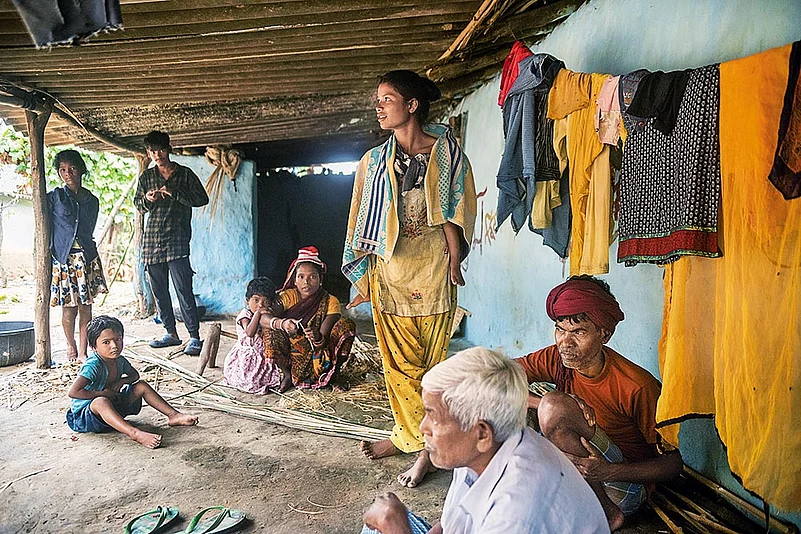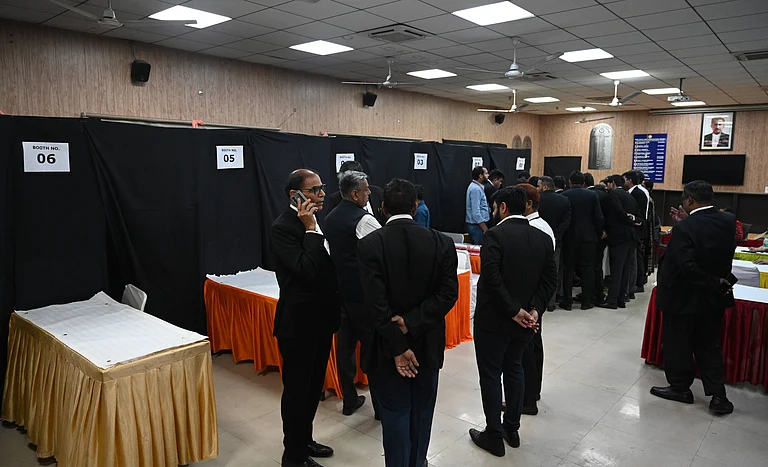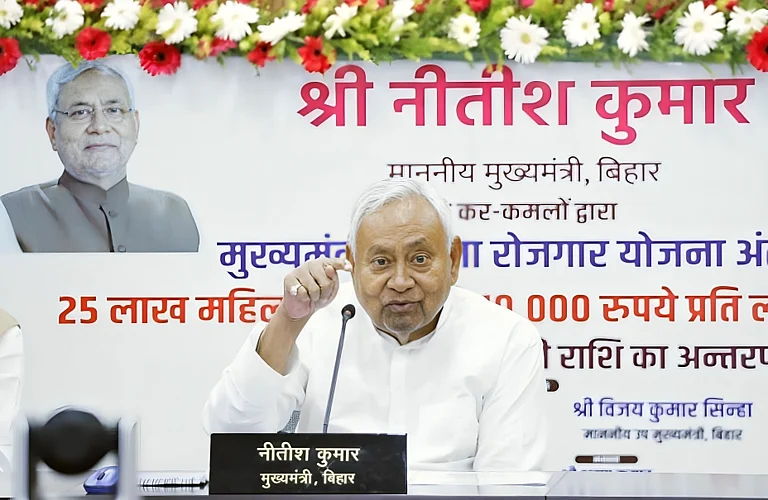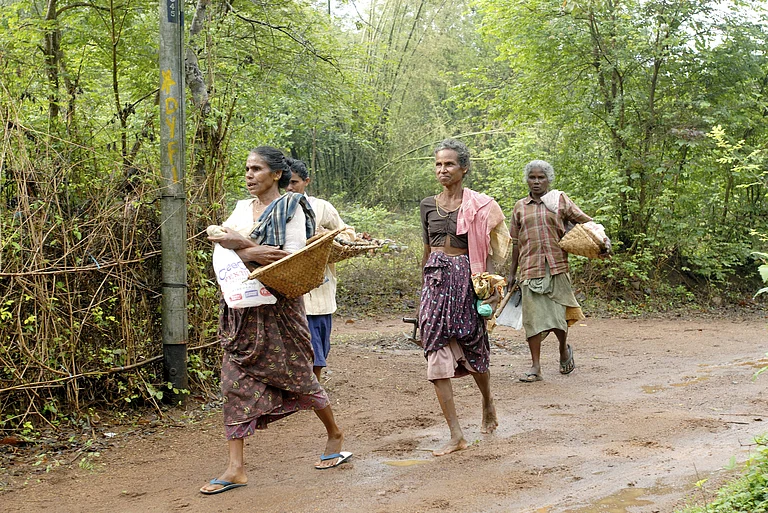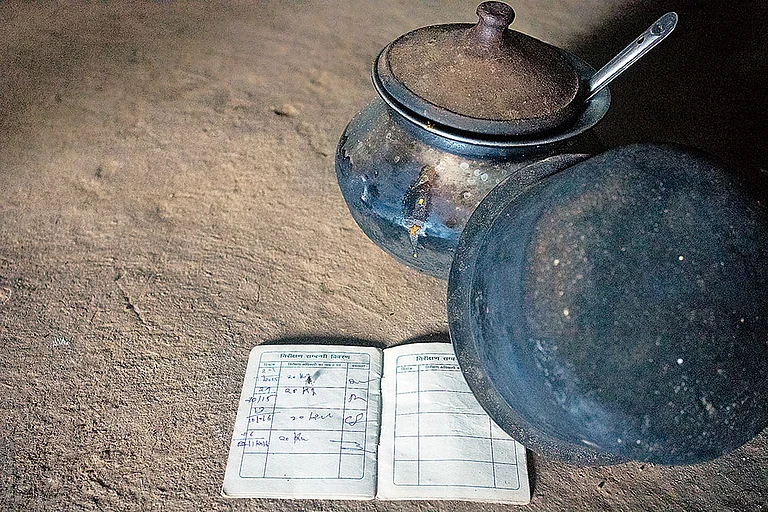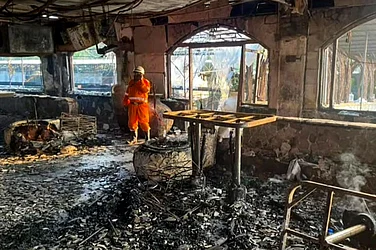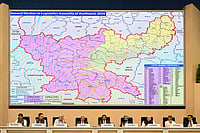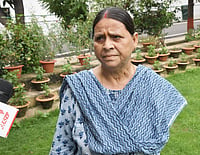Last year, on August 27, Masiyatu Tola—a remote hamlet nestling in the lap of the mountains in Kuro block of Lohardaga in Jharkhand—was all decked up. A tent was erected at the Akhra (tribal place of worship) in front of Hari’s house to accommodate more than a 1,000 people. Hari, his family of 15, and other villagers were excited since morning. It was the day Prime Minister Narendra Modi, through his Mann Ki Baat, was going to address the tribal and the scheduled-caste residents of Masiyatu Tola—famous for its bamboo artisans.
The PM praised the artisans, assured them a better market for their craftsmanship and spoke of making them aatmanirbhar (self-reliant). The fortune of these artisans and the hamlet with 70 houses should have changed after that, but it didn’t. A year later, Masiyatu Tola is still largely dependent on outward migration. Take for instance Hari, 55. Ten members from his family—the youngest is 17 and the eldest is 45—work at brick kilns in Uttar Pradesh for seven months in a year. They returned from a kiln just three months ago.
Jharkhand has abundant reserves of coal, bauxite, iron and mica. Despite this, its people are the poorest.
Hari’s daughter Anita, 19, recalls the promise PM Modi had made to uplift them economically by providing them with a good market and remunerative prices for their bamboo products, “So far, we haven’t got anything. We don’t even get the right price for our bamboo products. We don’t earn enough from our craft to run the household around the year. Nor can we rely on agriculture. There has been a dry spell for two years and the prospects of rain this time around don’t seem very bright.”

Most homes in the village have members who have migrated either to the brick kilns of Uttar Pradesh or to Kerala and Gujarat in search of work. Ironically, the villages and towns bearing the brunt of this migration belong to the bauxite city of Lohardaga that contributes six per cent of the country’s bauxite reserves. According to the Indian Mineral Year Book 2020, in just three years (2016-19), bauxite worth Rs 611.6 crore was extracted from these areas. What part of this amount was spent on the development of the tribals of Lohardaga and its surrounding districts? The answer can be found in the growing phenomenon of migration.
The government has no official data on the number of workers migrating out of Jharkhand. However, the calls received on the government helpline during COVID-19 provide a good indication of the depth of the problem. During the first wave of the pandemic, about 11 lakh migrant labourers appealed for help on the helpline number. The actual number of migrants is certain to have been much higher than this figure. According to a report, each year, 50 lakh people migrate from the state.
The question is often posed: why does a state rich in mineral wealth face the scourge of migration? The workers reeling under financial constraints, unemployment, declining agriculture, and government neglect respond: “We are helpless.”

Jharkhand has abundant reserves of coal, bauxite, iron, and mica. Officially, it accounts for 40 per cent of the total mining in the country. Despite this, its people are the poorest. According to the NITI Aayog 2021 report, Jharkhand is second in terms of poverty (42.26 per cent), right behind Bihar (51.91 per cent).
A 2017 study titled Impact of MGNREGA on Rural-Urban Migration Study shows that Jharkhand has been a major source of migrant populations for the rest of the country and between 2001 and 2011, a staggering 50 lakh young workers emigrated from the eastern state.
According to the report, while the country progressed thanks to the mineral wealth coming out of the state, its own tribals plunged into deeper poverty. With an increase in the number of mines and factories on tribal land, the displacement of the tribal population also increased.
***
Climate change has also played a role in the state’s migration crisis. Thirty-seven-year-old Ravindra Lohra is among those who became a victim of that change. Frequent droughts forced him to migrate from his native Jhakra Toli in the Kuru block. He was able to return recently, after spending the last eight years away in Bhavnagar, Gujarat.
His wife Priti Lohra says: “We farm on a shared plot of 10 keyaris [1 keyari = 10 decimals]. There’s been such a severe drought for the last two seasons that we haven’t managed to grow rice even for our own consumption. With the rains playing truant again this year, sowing has been delayed by a month. We have little hope of reaping paddy.” Earlier, when the rains arrived on time, the couple would get a yield that lasted them the whole year. To meet their cash needs, they would take up wage labour in nearby Lohardaga or Ranchi.
Seasonal migration has long been common in Jharkhand. But now migrants are staying away throughout the year.
Why did Ravindra travel as far as Gujarat to make Rs 400 a day? Why could he not find work in Ranchi or some other city of Jharkhand? Says Priti, “First of all, there is no work here. Secondly, even if we find work, the wages are low. Thirdly, there is no regular work to be found. It was these considerations that compelled him to go out. Had he stayed, we couldn’t have raised our two children and sent them to school.”
Climate change has affected the rural population at many levels and the situation is expected to get worse in the coming times. A report by the World Bank predicts a terrifying scenario of climate-induced migration in 2030-2050.
A seasonal migration of the tribals has long been common in Jharkhand. However, this is now turning into a trend where the migrants stay away from their homes throughout the year. The hilly terrain of the state contains few irrigation facilities; about 80 per cent of the agricultural lands depend on rainwater alone. This allows for only single-crop farming, with paddy being grown on most of the land.
According to the 2011 census, 65 per cent of the rural population here is involved in agriculture. Once the paddy season is over, the people have six to seven months of time remaining. If they do not find work locally during these months, they migrate. This is a seasonal form of migration. But in the last 25 years, this trend of migration has changed, with a large population of the tribals now living and working outside the state around the year.
Before independence, the British moved the tribals of Jharkhand to other states, especially to the tea plantations of Assam, as labourers. In the three decades following 1950, they migrated to Bihar and Bengal as agricultural workers. But after 1980 began the trend of migrating to big cities, which continues to this day.
Behind this shift since 1980-90 lies the environmental transformation brought on by climate change. Indiscriminate mining and reckless felling of trees have had a huge impact on agriculture here. In the 23 years since the formation of Jharkhand in November 2000, the state has been hit by droughts as many as 15 times.
At the same time, large-scale acquisition of tribal land for mining projects has also been a major factor behind the tribals taking the migration route in search of livelihood.
The scale of this migration has resulted in a sharp reduction in the tribal population residing in the state. There have been two population censuses in Jharkhand since its separation from Bihar. It was found that between 2001 and 2011, the total population of the state increased from 2.69 crore to 3.29 crore, but the percentage of tribals decreased from 26.30 to 26.21 per cent. The eight primitive tribes among its 32 tribes are on the verge of extinction due to migration. Mining in the mountains of the Santhal Pargana has forced the Pahadia community living there to migrate.
Large-scale acquisition of Tribal land for mining has been a major factor behind tribals taking the migration route in search of Jobs.
Jyoti Prakash, a professor at Ranchi University, views the stagnation of the state’s tribal population over the past ten years with concern and holds outward migration to be the culprit. Prakash, who conducts research on the tribal population under the Tribal Research Institute, Ranchi, says: “What happens is that when a tribal migrates from a village, the census takers are unable to count them. This is called undercounting. I’m certain that if they had not migrated, their population figure would have shown an increase of at least two per cent.”
Tribal migration has always been a political issue. The governments have brought employment-related schemes from time to time to check the trend, but in the absence of concrete policy measures, these have not been implemented. It has been the oft-repeated stand of the Jharkhand Mukti Morcha that it will introduce a provision or law to legalise the claim that the people have the first right to the mineral wealth of the state.
Champai Soren, the then Chief Minister, said on the occasion of Hul Diwas, that Jharkhand is not a poor state, but a rich one; its natives, however, are poor. He added that Delhi, Mumbai, and Gujarat have grown on the basis of the mineral wealth provided by Jharkhand, whereas the tribals and natives of the state have failed to do so. His government, he promised, will one day bring a law that says that the mineral wealth of the state belongs to its tribes and natives.
Bhuvaneshwar Kewat, state general secretary of the Jharkhand Nirman Mazdoor Union, is of the view that after the formation of the state, no government has made an honest effort to stop migration. He lists several reasons for migration taking place unabated. “Generally, the big companies here have a policy of low costs and high profits, so they pay the minimum wages. Jharkhand has the lowest minimum wages in the entire country,” he says. “Secondly, these companies do not like the workers of Jharkhand. Instead of providing employment to the workers living around, the outsourcing companies operating in Jharkhand hire workers from other states,” he adds.
Kewat asserts that the companies do this as part of a strategy. Employing non-local workers ensures that in the eventuality of a workplace accident, work is not interrupted and the affected worker does not have to be paid a large amount of compensation. Kewat believes that a concrete policy intervention in this regard can help check migration to a great extent.
The Hemant Soren government in the state has made some effort in this direction. The Jharkhand State Employment of Local Candidates in Private Sector Act, 2021 was legislated to mandate the appointment of local candidates in 75 per cent of the jobs in the public and private sectors. The government monitors progress on this front by sending periodic notices to private-sector companies regarding the implementation of the act.
In addition to the factors mentioned above irregularities and scams in the MGNREGA scheme have also been behind the continued migration from the state. Post the coronavirus pandemic, the government increased the wage rate in MGNREGA from Rs 190 to Rs 255. But Right to Food activist Swati Narayan believes that this is still very low. She relates the government’s apathy towards increasing the wage to the fact that MGNREGA employs more women than men and the government believes that women will accept without demur whatever wages are offered to them.
In most states, MGNREGA wages are less than the minimum wages fixed by the state. This is despite the Supreme Court ruling that said that workers employed under government schemes cannot be paid less than the minimum wages.
According to the registrations on Jharkhand’s e-Shram portal, the state has 1.11 crore workers employed variously. These workers are neither covered by PF provisions nor have fixed monthly salaries. For decades, they were not even registered and counted as workers by the government. It was only in recent years that a process was begun to register them on the state’s e-Shram portal. Among the registered workers of the unorganised sector, over 55 lakh are labourers working in agriculture. The MGNREGA scheme 2023-24 provided employment of 7.92 crore man-days to the people of the state till November 2023.
Migration has been a political issue for every state. In the north, it has raised serious questions regarding the various state governments’ claims of development.
MORE FROM THIS ISSUE
According to the 2011 census, there were 45.36 crore migrants in the country, which was 37 per cent of the population. Among these, 60 per cent of those migrating from rural parts were Dalits and tribals. Most of them migrated from the states of Uttar Pradesh, Jharkhand, Madhya Pradesh, Odisha, Bihar, and West Bengal.
(Translated by Kaushika Draavid)
(This appeared in the print as 'People Who Carry The Sky')







